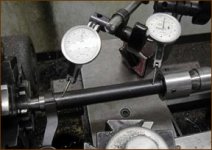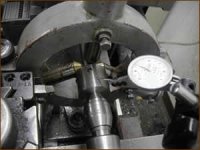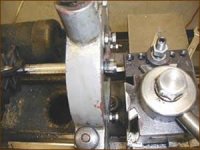To true the bolt face or lugs in the lathe, you have to make sure that the bolt body is running true in the lathe. I've seen some jigs made for truing bolt faces, that it's beyond me how you tell whether the bolt is running true in the fixture. After years of threading bolt plugs to fit 700's and then turning the bolt around and chucking it up and turning the rear of the plug concentric, I made what looks like a threaded trailer ball in miniature. It's threaded 1/2-13 on one end and a ball on the other. The ball lets the bolt pivot in the chuck. I've been using the same ball for probably 20 years and it looks like it now. But, it still works. You can center the bolt nose on the firing pin hole, but it may or may not be in the center of the bolt body. Instead of centering on the firing pin hole, on the bolt nose end of the bolt there is a fixture that goes around the outside of the bolt nose that has four set screws to move the bolt head around in the lathe. The adjust tru chuck adjusts runout on the rear of the bolt to the minimum for however round or out of round that the rear of the bolt is and the fixture at the front adjusts the front of the bolt to get it running as true as you can get it. The steady rest would be in place with nothing touching the bolt body, but is not in place for clarity of showing how to indicate the bolt in with the first photo. The second photo shows the steady rest in place with a dial indicator resting against the bolt nose fixture to make sure that the steady rest points don't push the bolt out of the lathe centerline when the steady rest points are adjusted. I face bolt faces off under power feeding from the outside of the bolt face in towards the firing pin hole. Then polish the bolt face with a dowel wrapped with 320 grit sand paper to finish off the bolt face. The photos are old photos as I haven't had the lathe in the photo for a number of years. In the third photo, the compound is turned parallel to the lathe bed and turned in to just touch the bolt face. You want to take off the very minimum depth of cut to just clean up the bolt face. Some factory bolt faces are pretty rough and what you want when you are done is a bolt face that is perfectly perpendicular to the bolt body and with a good smooth finish across the bolt face. That's about all there is to it. If you want to center on the firing pin hole, you can make split bushings that epoxy to the bolt body front and back and tighten up the fit of the bolt to the receiver raceway. But, if you are just starting out, I'd wait until you have a lot more experience with your machinery before you go that route.
View attachment 21235 View attachment 21236 View attachment 21237





